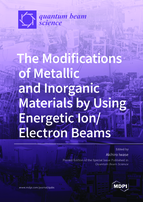Chromatic Change in Copper Oxide Layers Irradiated with Low Energy Ions
Round 1
Reviewer 1 Report
The authors investigate the colour change of a copper oxide layer on copper after 5 keV Ar+ irradiation at high vacuum conditions using RBS, NRA, and XPS. The results are well presented and support the assumption that the observed colour change is a direct result of a irradiation induced change in chemical composition of the copper oxide layer.
Comments:
-- In the introduction the colour change is promoted to be used as a beam monitor. However, there is little discussion about the sensitivity of the effect, e.g. what level of fluence fluctuation should be visible at different fluences like 1e14 cm-2, 1e15 cm-2, 1e16 cm-2 and so on. It would be nice if the authors could include a more detailed discussion in the manuscript and add to the conclusion their assessment of how feasible this effect is as a new type of beam monitoring device.
-- The authors mention that the colour change is a combination of irradiation induced compositional changes and the layer thickness. It would be good to include a discussion about what determines the layer thickness; is it the thickness of the thermally grown oxide layer, the penetration depth of the ion beam, and what influence dose sputtering has on these values.
-- The authors state that they have determined the composition and thickness (line 92) but didn't mention the thickness. How thick is the oxide layer before and after irradiation?
Author Response
Please see the attachment.
Author Response File: ![]() Author Response.pdf
Author Response.pdf
Reviewer 2 Report
This paper is clearly written and the authors’ concept can be well followed. However, as the studied system is a very thin layer and the authors try to follow small changes within this, their assumptions and explanation requires more support from experimental side. My comments are as following.
- I am sorry to say, as it may be somewhat subjective, but the sample on Fig. 2(a) by my feeling is not really blue-purple. At least shows not very much similar color than the one shown in Fig. 2(b) in Ref. [38] of this paper. Also, it remained a question for me if the colors were observed in the sample chamber under vacuum conditions or after the samples were removed to air? I.e., Fig. 2 shows the samples on air? Of course, if so, than chemical surface reactions could take place under atmospheric pressure.
- The authors do not show SRIM simulations for the 5 keV Ar+ implant and do not give the irradiation geometry. I mean was the irradiation performed perpendicular to the surface or at a tilt angle? SRIM gives abot 5 nm projected range for perpendicular direction and about 10 nm maximum penetration of Ar.
-According to the chemical state of CuOx, the authors recalculate the Cu:O ratio for the entire layer which may be about 20-25 nm, as derived from RBS. However, as the 5 keV Ar projected range is about 5 nm, the direct impact of Ar ions is not likely through the whole layer. What is the opinion of the authors about this point?
-The authors do not show reference RBS spectrum for the CuOx layer, before the irradiation. However (i) surface roughness of the CuOx layer may have influence on the Cu edge of the RBS spectrum and therefore on the evaluated O content. (ii) As RBS cannot see oxygen directly because of its low RBS yield, it may be dangerous to use the Cu edge alone for the estimation of the oxygen content. (iii) Also, in the irradiated sample, the spectrum from Ar should be seen or at least Ar can be considered in SIMNRA simulations. The presence of Ar also has influence on the RBS Cu edge shown in Fig. 3, as several atomic percents of Ar is expected to built in the near surface region according to SRIM. This may appear as a decrease in the RBS Cu yield at the surface. The authors should give additional information on these details.
-The NRA experiment shows the decrease of the O content by 10%. The authors here should account for the experimental uncertainty. For 2000 NRA counts by a rough estimation it should be about ± 2-2.5%. This gives an error also for the O content change. On the other hand, the change of the Cu content was not followed, but, if sputtering occurs than Cu atoms may be sputtered out as well, even if their sputtering yield is less than for oxygen. This effect may have influence on the final Cu:O ratio. The authors may have comment on this.
-XPS shows the change in the chemical state of Cu. This seems to support the authors assumption on the changing Cu:O ratio. However, this change may be restricted to the surface region of the 20 nm CuOx layer. Some high depth resolution measurement, like SIMS, Auger depth profiling, or MEIS/LEIS (medium or low energy ion backscattering) may help to see concentration changes of Cu and O vs. depth.
-The color change of the layer may be associated also with refractive index change. E.g., because of chemical state change, and also, because of Ar incorporation and/or damage formation. The authors should account for such effects in the paper. By this sence the colors are not directly comparable to those shown in Ref [38] where ion bombardment was not applied.
Author Response
Please see the attachment.
Author Response File: ![]() Author Response.pdf
Author Response.pdf
Round 2
Reviewer 2 Report
After introducing changes to the original manuscript the questionable points were explained or mentioned in the text, therefore I can propose to publish the paper in the present revised form.




